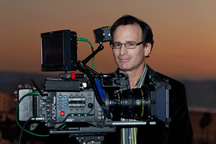
Film stock is an analog medium that is used for recording motion pictures or animation. It is a strip or sheet of transparent plastic film base coated on one side with a gelatin emulsion containing microscopically small light-sensitive silver halide crystals. The sizes and other characteristics of the crystals determine the sensitivity, contrast and resolution of the film. The emulsion will gradually darken if left exposed to light, but the process is too slow and incomplete to be of any practical use. Instead, a very short exposure to the image formed by a camera lens is used to produce only a very slight chemical change, proportional to the amount of light absorbed by each crystal. This creates an invisible latent image in the emulsion, which can be chemically developed into a visible photograph. In addition to visible light, all films are sensitive to X-rays and high-energy particles. Most are at least slightly sensitive to invisible ultraviolet (UV) light. Some special-purpose films are sensitive into the infrared (IR) region of the spectrum.
Video editing software is an application program which handles the post-production video editing of digital video sequences on a computer non-linear editing system (NLE). It has replaced traditional flatbed celluloid film editing tools and analogue video tape-to-tape online editing machines.

Avid Technology is an American technology and multimedia company founded in August 1987 by Bill Warner, based in Burlington, Massachusetts. It specializes in audio and video; specifically, digital non-linear editing (NLE) systems, management and distribution services.

The movie camera, film camera or cine-camera is a type of photographic camera which takes a rapid sequence of photographs on an image sensor or on a film. In contrast to a still camera, which captures a single snapshot at a time, the movie camera takes a series of images; each image constitutes a "frame". This is accomplished through an intermittent mechanism. The frames are later played back in a movie projector at a specific speed, called the frame rate. While viewing at a particular frame rate, a person's eyes and brain merge the separate pictures to create the illusion of motion.

LaserDisc is a home video format and the first commercial optical disc storage medium, initially licensed, sold and marketed as MCA DiscoVision in the United States in 1978.

Rotoscoping is an animation technique that animators use to trace over motion picture footage, frame by frame, to produce realistic action. Originally, animators projected photographed live-action movie images onto a glass panel and traced over the image. This projection equipment is referred to as a rotoscope, developed by Polish-American animator Max Fleischer. This device was eventually replaced by computers, but the process is still called rotoscoping.

Dolby Laboratories, Inc. is an American company specializing in audio noise reduction and audio encoding/compression. Dolby licenses its technologies to consumer electronics manufacturers.

Walt Disney Studios Home Entertainment is the home video distribution division of The Walt Disney Company. Disney began distributing videos under its own label in 1980 under the name Walt Disney Home Entertainment.
Alex Chandon is a film director, writer and digital artist.

Gonzo pornography is a style of pornographic film that attempts to place the viewer directly into the scene. Jamie Gillis is considered to have started the gonzo pornography genre with his On the Prowl series of films.
A digital backlot is a motion picture set that is neither a genuine location nor a constructed studio; the shooting takes place entirely on a stage with a blank background that will later on project an artificial environment put in during post-production. Digital backlot is more often used in certain genre of films, like sci-fi and comics, in order to achieve what would otherwise be too expensive or outright impossible to build as a real set.

The Showroom Cinema is an independent arthouse cinema in Sheffield, England. It is housed in a 1936 art deco building which was formerly the Kennings car dealership. It was first opened in 1993 with two screens; further phases of development have added another two screens, a bar and cafe and a meeting room, making it one of the attractions of Sheffield's Cultural Industries Quarter, in the south-east of the city centre.

The Miller Group Advertising, Inc. is a full-service digital advertising and marketing agency in Los Angeles specializing in Brand Revitalization and new product launches. It was founded in 1990 by Renee Miller, the agency's president and creative director. The Miller Group is headquartered in Los Angeles, California. The agency has won many creative awards over the years and has worked on a number of national brands, including Kenwood Electronics, Goodwill, RE/MAX, General Electric and Anthem. More recently, the agency has worked with simplehuman, PSAV, Health Strategies Group, and Centra Credit Union.
Celluloid Dreams is a French film production and distribution company which is also an international sales company as well. They also run a video on-demand platform, The Auteurs, in conjunction with The Criterion Collection. Celluloid Dreams have been involved in films such as Palindromes, The Edukators, Son of Rambow, DiG!, I'm Not There, How She Move and Funny Games. As well as that, they have their own YouTube channel CelluoidDreams, and have uploaded the trailer to the award-winning animated The Secret of Kells.

A film, also called a movie, motion picture, moving picture, or photoplay, is a series of still images that, when shown on a screen, create the illusion of moving images.
Articles related to the field of motion pictures include:

Jeffrey Friedman is an American filmmaker. In 2019, he and Rob Epstein were nominated for an Academy Award for their work in the documentary film End Game.
Exceptional Minds is the first American computer animation studio and non-profit digital arts school for young adults on the autism spectrum. It is located in Sherman Oaks, Los Angeles, California.
John Carbutt (1832-1905) was the first person to use celluloid for photographic film.














